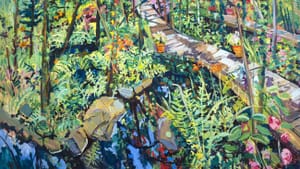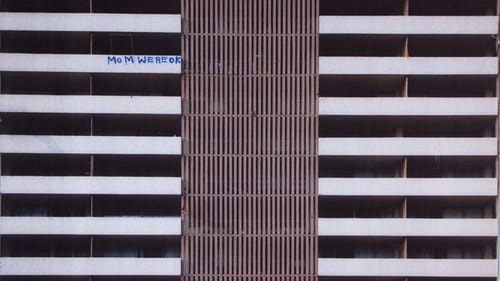Stay in the Loop
BSR publishes on a weekly schedule, with an email newsletter every Wednesday and Thursday morning. There’s no paywall, and subscribing is always free.
Two sides of the same coin
Look Both Ways at Woodmere Art Museum

When you get right down to it, all art is abstract: three dimensions are compressed into two, lace is replicated in marble, and fire rendered in watercolor. Abstraction in art is simply a matter of degree and state of mind: Didn’t van Gogh think Starry Night a perfect portrait of the evening sky?
Though it’s obvious that some works are wholly abstract (looking at you, Pablo) and others totally representational, it’s difficult for people who don’t draw or sculpt to perceive how frequently the two approaches intermingle. This point is driven home at Woodmere Art Museum in the rambling exhibition Look Both Ways: Art at the Crossroads of Abstraction and Representation.
Something for everyone
There is a lot to take in. The exhibition consists primarily of pieces from the Woodmere collection by artists with Philadelphia connections. There are works for everyone to savor, and with those beyond personal tastes, well, linger a while. Exposure may breed appreciation.
Inside Summer’s Garden (1996), John Laub’s lush painting, strikes a balance. It’s big, maybe six feet square, and instantly transports viewers into a junglelike enclave with a brook rimmed by a boardwalk. Inspect just a tiny portion, however, and you lose all landmarks, seeing only bold swooshes of color that build to the representational whole.
Doris, I need a title
Standing back from Doris Staffel’s Untitled (1942) won’t help. It’s a patchwork of mauve, tan, brown, and green masses interrupted with a few thin black lines. Pure abstraction that, to me, is not compelling. But I squinted, and imagined I was standing behind a big sofa, looking through a mountain range of pillows into a living room. Maybe I saw a terrarium. According to the curator’s note, Untitled is an “amalgam of nature.” Oh. That must have been the terrarium.
So thank you, Madeline Peckenpaugh, for titling Neither Can I (2014), and teasing us with this clue about your paintings: “I want them to feel like a tangible, recognizable space, but also have notes of confusion. I strive for a level of comfort, but there is a struggle to get through the painting before you can reach it.” Yup. Neither Can I is a Rorschach test of a painting. Since Peckenpaugh’s title made me laugh, I stood there for a while, struggling. I saw a fox peeking out from under brush, a pale schooner sailing across the canvas, the nose of a reindeer, and Santa in a pine tree with bluebirds circling his head. I never achieved any level of comfort.
Though I don’t find abstraction as enticing as representation, some images in Look Both Ways are a joy to contemplate. Witness Fruitful Darkness (1997) by Bruce Pollock, in which armies of variously sized circles merge, white from the bottom, black from the top. A crimson vine winds through the field, curving around the spheres like an invasive plant. It is an interesting, beautiful image. I don’t know what it represents and I don’t care.
In the way of a dream

There is also art that is abstract in the way of a dream: The components are identifiable, but the context makes no sense. In Leon Kelly’s surreal drawing The Owl of Caceres (1958), a man sits at a table gazing up at an owl, holding a lit match over a candelabra. The owl perches atop a birdcage. There are bars on the man’s window, and a fort or castle in the distance. Across the room, a cat sits on a dresser looking into a mirror, perhaps at the owl’s reflection. Tuck that image away for when dinner conversation wanes.
Or, if your dinner companion is erudite, try discussing Kabirion (1996) by Thomas Chimes. It consists of faint lines on a white field, depicting a man in a hat, the triangle-in-a-circle symbol that starts web videos, and the map of a coastline. The curator notes explain that this is Chimes’s alternative universe, containing references to Alfred Jarry, a French poet and surrealist playwright. And Kabirion is a sanctuary in Greece, which may be what the coastline represents.
Everyday abstractions
A few works in Look Both Ways stand perfectly at the center of the intersection of abstraction and representation. As you look at these, recognizable images appear and disappear, the way they do in a trompe l’oeil.
In seconds, Gertrude Fisher-Fishman’s The Apartment (date unknown), magically transforms from blocky abstraction — white, charcoal, and pitch black quadrilaterals — into the dark interior of an apartment, its entry partially illuminated from an outer hall.

Similarly, photographs by Zoe Strauss and Nona Hershey. Detail I-95 (Mom Were OK) (2001-5) by Strauss is one of a series made in Mississippi after Hurricane Katrina devastated the Gulf Coast. A long shot of a parking garage, it’s a pleasing geometric abstraction that snaps into context once you notice the tiny sign hanging from one level, “Mom Were OK.” In Hershey’s May 1981 (1981), sunlight penetrates drawn blinds in a darkened room, releasing a Morse code of dots across a billowing curtain. Besides presenting a pretty image, the picture evokes the experience of lying in bed as a breeze cools you as blinds clack and curtains rustle.
Art is not a map
“I never know what a painting is ‘about . . . it simply has resonance for me,’” said Frank Bramblett. His mixed-media Tête-à-tête (1999) is on view, with rose-toned ovals that could be a giant’s fingerprints. It doesn’t matter where one stands at the abstraction/representation crossroad: Eventually, something comes along to transport each of us. As Bramblett said, “Art is not a map, but a prompt.”
What, When, Where
Look Both Ways: Art at the Crossroads of Abstraction and Representation. Through May 15 at Woodmere Art Museum, 9201 Germantown Avenue, Philadelphia. 215-247-0476 or woodmereartmuseum.org
Sign up for our newsletter
All of the week's new articles, all in one place. Sign up for the free weekly BSR newsletters, and don't miss a conversation.
